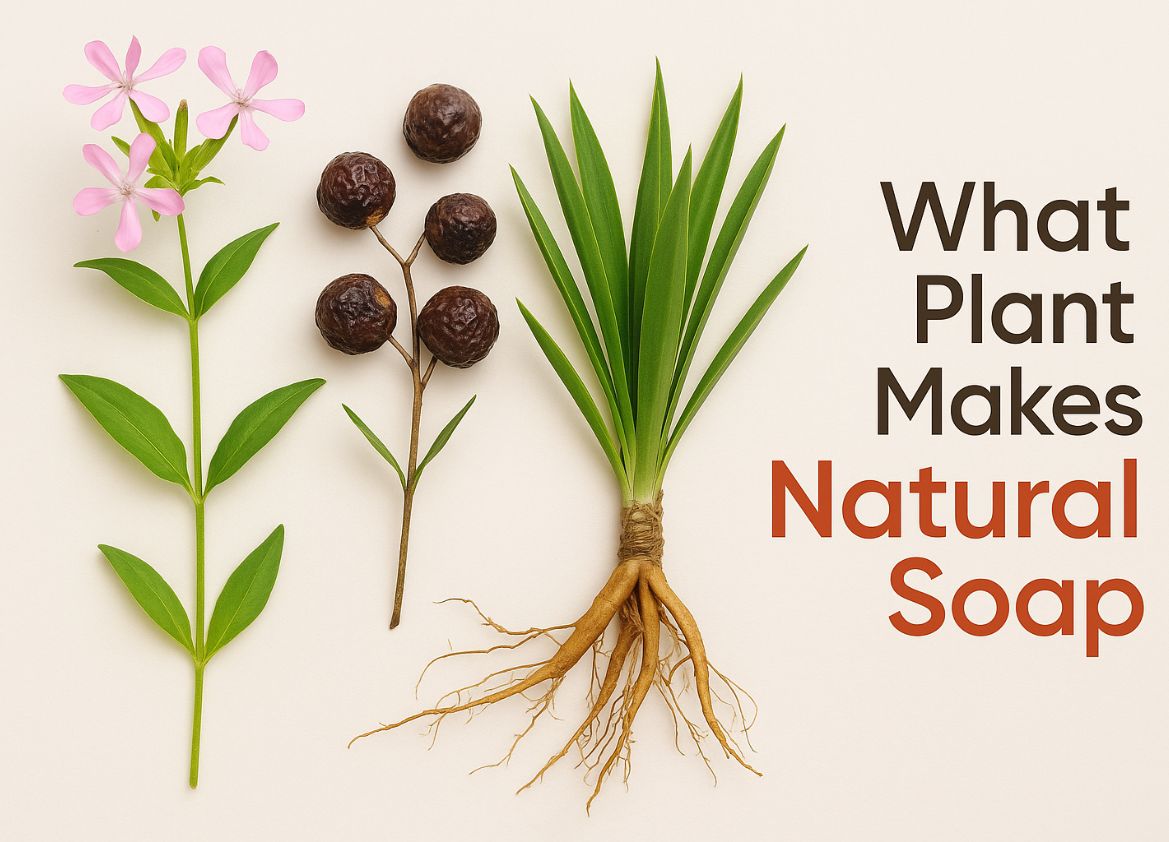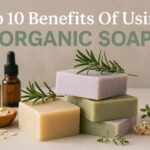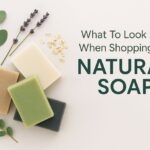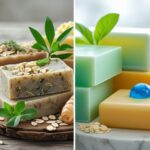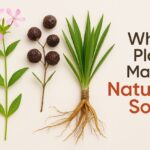Ever picked up a commercial soap and wondered what exactly those unpronounceable ingredients on the label actually do? You’re not alone. Over the years the demand for natural, plant-based alternatives has exploded as consumers ditch synthetic chemicals for cleaner options.
But here’s what’s fascinating, long before fancy soap factories existed, our ancestors were using plants to get squeaky clean. Nature has provided us with incredible botanical soap-makers that contain natural cleansing compounds no chemistry lab required.
So what plant makes natural soap?
Plants containing saponins, soapwort, yucca root, and soapberry. They naturally create a foamy lather when agitated in water and have been traditionally used as natural soap for thousands of years across different cultures.
Key Takeaways
- Saponin-rich plants like soapwort, soapberry, and yucca naturally create soap due to their foaming compounds
- Natural plant soaps are gentler on skin and more environmentally friendly than many commercial alternatives
- You can easily make DIY soap using these plants or incorporate plant-based oils like coconut, olive, and shea butter
- Plant-based soaps offer antibacterial and antifungal properties without harsh synthetic ingredients
- The best natural soap plants have been used for centuries across indigenous cultures worldwide
Learn About Natural Soap
What Makes a Soap “Natural”?
Natural soap isn’t just a marketing buzzword – it’s a fundamentally different product from what most people use daily. True natural soap contains ingredients derived directly from plants: oils, herbs, botanicals, and crucially, plants with natural saponins.
Saponins are nature’s soap molecules – organic compounds that create foam when agitated in water. When you see a plant like soapwort creating bubbles, you’re witnessing these remarkable compounds in action.
“Natural soap isn’t just better for your skin – it’s better for the planet. The same saponins that clean your body break down completely in the environment, unlike synthetic detergents.”
Commercial Soap vs. Plant-Based Soap
Let’s break down the key differences:
| Commercial Soap | Plant-Based Soap |
|---|---|
| Contains synthetic detergents (SLS, SLES) | Uses natural saponins or plant oils |
| Often includes artificial fragrances | Scented with essential oils or herbs |
| May contain parabens and phthalates | Free from synthetic preservatives |
| Can strip skin’s natural oils | Tends to be more moisturizing |
| Typically petroleum-based | Made from renewable plant resources |
| Often tested on animals | Usually cruelty-free |
The bottom line? Commercial soaps clean by using harsh detergents that strip away everything (including your skin’s natural moisture), while plant-based soaps gently cleanse while maintaining your skin’s balance.
Plants That Naturally Make Soap
Now let’s dive into the star players – the plants that naturally create soap without any human processing required!
Soapwort (Saponaria officinalis)
Soapwort isn’t just a clever name – this European native has been used as soap for centuries. Also called “bouncing bet,” this pretty pink-flowered plant packs a serious cleaning punch.
The roots and leaves of soapwort contain up to 5% saponins, making it one of the most potent natural soap plants available. When crushed and agitated in water, these parts create a rich, foamy lather.
Historically, soapwort was used for:
- Washing delicate fabrics (especially wool)
- Bathing infants and people with sensitive skin
- Cleaning fine textiles that could be damaged by harsh lye soaps
What makes soapwort special is its gentleness. Unlike many commercial cleansers that strip your skin, soapwort cleans without disrupting your skin’s natural pH balance.
Soapberry / Soapnut (Sapindus mukorossi)
If you’re looking for the most concentrated natural soap plant, soapberries win hands down. These small, brown fruits from the Sapindus tree contain up to 15% saponins – making them powerhouse cleaners.
Native to India and Nepal, soapberries (also called soap nuts) have been used for thousands of years across Asia for:
- Laundry washing (they’re effective enough for modern washing machines!)
- Hair cleansing
- Body washing
- Jewelry cleaning
Using soapberries is incredibly simple – just place 4-5 dried berries in a small muslin bag, wet them, and they’ll release their saponins. One handful can be reused for several washes before the saponins are depleted.
Yucca Root
Long before commercial soaps reached the American Southwest, indigenous peoples were using yucca root as their go-to cleanser. This desert plant stores saponins in its roots, creating an effective shampoo and body wash.
Yucca root soap is particularly effective for:
- Hair washing (it adds volume and shine)
- Scalp treatment (helps with dandruff and itchiness)
- Body cleansing in water-scarce environments
To use yucca traditionally, the root is pounded to expose the inner flesh, then rubbed directly on wet hair or skin. The lather is surprisingly rich and effective at removing oils and dirt.
Horse Chestnut & Quillaja Bark
While less commonly used, these plants deserve mention for their impressive saponin content:
Horse Chestnut (Aesculus hippocastanum): The nuts contain escin, a saponin complex that creates foam. Historically used in Europe for laundry.
Quillaja Bark (Quillaja saponaria): Also called soap bark, this Chilean tree contains such high levels of saponins that it’s commercially harvested for natural foaming agents in everything from root beer to fire extinguishers!
Plant-Based Oils & Herbs Used in Natural Soap Making
Beyond plants that naturally contain saponins, many other botanicals play crucial roles in natural soap making:
Base Oils: The Foundation
The foundation of any handcrafted soap is its oils. Each brings unique properties:
- Coconut Oil: Creates abundant, fluffy lather and hard bars
- Olive Oil: Extremely moisturizing and gentle (the base of traditional castile soap)
- Shea Butter: Adds luxurious creaminess and skin-nourishing vitamins
- Castor Oil: Boosts lather and adds conditioning properties
- Jojoba Oil: Closely resembles human sebum, making it particularly skin-friendly
Healing Herbs & Botanicals
These plant additions transform basic soap into therapeutic skin treatments:
- Lavender: Calming, antiseptic, and wonderful for all skin types
- Chamomile: Anti-inflammatory and soothing for sensitive skin
- Calendula: Healing for damaged or irritated skin
- Oatmeal: Gently exfoliating and soothing for eczema
- Aloe Vera: Deeply moisturizing and healing
Naturally Scented
Instead of synthetic fragrances, natural soaps use:
- Essential Oils: Concentrated plant extracts like peppermint, eucalyptus, and citrus
- Infused Botanicals: Herbs that release their scent and properties during the soap-making process
How to Make Natural Soap From Plants (DIY Guide)
Ready to try making your own plant-based soap? Here are two approaches – one using saponin-rich plants directly, and another incorporating plant oils into traditional soap making.
Method 1: Direct Plant Saponin Extraction
This is the simplest method that requires no lye or complex chemistry:
- Gather your materials:
- 1 cup chopped soapwort roots/leaves, OR
- 5-6 soapberries, OR
- 1 cup chopped yucca root
- 2 cups water
- Cheesecloth or fine strainer
- Optional: dried herbs for scent (lavender, rosemary)
- Extract the saponins:
- Combine plant material and water in a pot
- Bring to a gentle boil, then reduce to simmer for 15-20 minutes
- The liquid should turn brownish and foam when stirred
- Strain and store:
- Pour through cheesecloth to remove plant material
- The resulting liquid is your natural soap!
- Store in a glass jar in the refrigerator for up to 1 week
- Usage:
- Use as a gentle shampoo, hand soap, or for delicate laundry
- For solid soap, you can reduce the liquid further and pour into molds
Method 2: Traditional Soap Making with Plant Oils
For a more conventional soap that hardens into bars, you’ll need to use lye (sodium hydroxide) with plant oils:
- Safety first!
- Wear gloves, eye protection, and work in a well-ventilated area
- Lye is caustic until fully transformed in the soap-making process
- Basic recipe ingredients:
- 10 oz coconut oil
- 20 oz olive oil
- 3.5 oz lye (sodium hydroxide)
- 9 oz distilled water
- Optional: 1 oz essential oil, 1 tbsp dried herbs
- The process:
- Dissolve lye in water (always add lye to water, never the reverse)
- Allow lye water to cool to 100-110°F
- Melt oils to the same temperature range
- Slowly blend lye water into oils until mixture thickens (“trace”)
- Add essential oils and herbs
- Pour into molds and insulate
- Cut after 24 hours, then cure for 4-6 weeks
⚠️ Safety Note: Always use a proper soap calculator to determine exact lye amounts for your specific oil blend. Too much lye can result in harsh soap, while too little means your soap won’t properly solidify.
Benefits of Plant-Based Soap
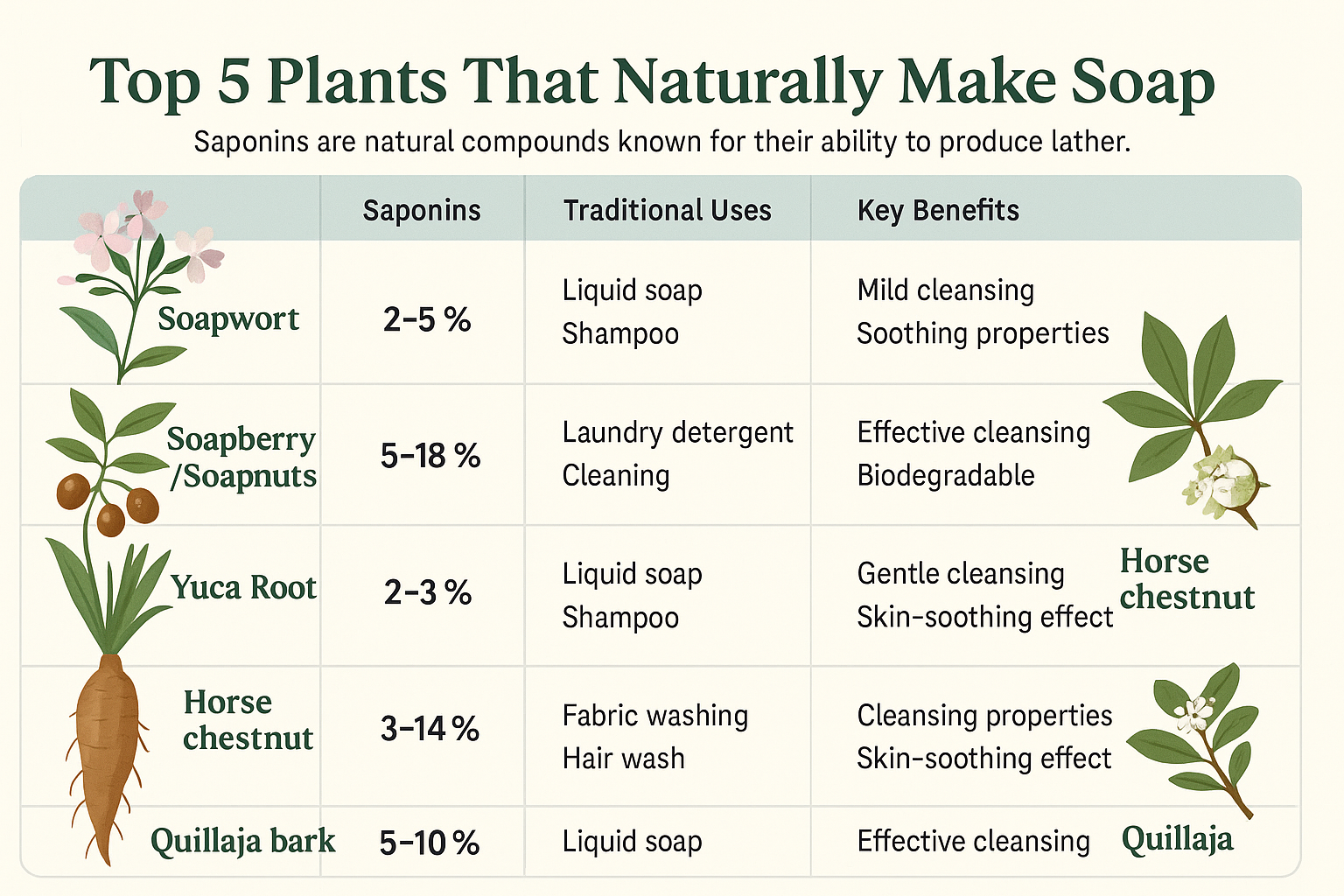
Making the switch to plant-based soap isn’t just a trendy choice – it offers legitimate advantages for both your skin and the environment.
Gentle on Skin
Plant-based soaps typically:
- Maintain your skin’s natural pH rather than disrupting it
- Preserve natural oils instead of stripping them away
- Contain glycerin (a natural byproduct of soap-making that commercial manufacturers often remove)
- Reduce irritation for sensitive skin conditions
Eco-Friendly Advantages
The environmental benefits are significant:
- Biodegradable ingredients break down naturally in water systems
- Renewable resources instead of petroleum derivatives
- Lower carbon footprint in production processes
- Reduced packaging waste (many come with minimal or plastic-free packaging)
Natural Therapeutic Properties
Many plant-based soaps offer benefits beyond basic cleansing:
- Tea Tree: Natural antibacterial and antifungal properties
- Neem: Helps with skin conditions like eczema and psoriasis
- Charcoal: Draws impurities from skin
- Clay: Detoxifies and exfoliates
Myths & Misconceptions About Plant-Based Soap
Despite the growing popularity of natural soaps, several myths persist. Let’s bust them!
Myth 1: Plant Soap Doesn’t Clean Effectively
The Truth: Saponins are extremely effective cleansers. In fact, some plants like soapberry are so effective they’re used commercially in natural laundry detergents powerful enough for modern washing machines.
Myth 2: Natural Soap Doesn’t Lather
The Truth: While some natural soaps (particularly those made with olive oil) produce a creamier rather than bubbly lather, saponin-rich plants create abundant foam. Soapwort can produce lather rich enough to wash hair effectively.
Myth 3: Plant-Based Soaps Are Too Expensive
The Truth: While artisanal soaps can be pricey, basic plant-based options like soapberries are extremely economical – one bag of soapnuts can replace months of laundry detergent. DIY options using soapwort or yucca are even more affordable.
Myth 4: All “Natural” Labeled Soaps Are Plant-Based
The Truth: The term “natural” isn’t regulated, so many products with this label still contain synthetic ingredients. Always check ingredient lists or look for certifications like USDA Organic or COSMOS Natural.
Best Plant-Based Soap Brands to Try in 2025
If DIY isn’t your thing, here are some outstanding plant-based soap brands worth trying:
Luxury Artisan Options
- Potager Soap Co.: Handcrafted soaps featuring garden herbs and essential oils. Their lavender oatmeal bar is perfect for sensitive skin.
- Osmia Organics: Founded by a doctor, these soaps are formulated specifically for problematic skin conditions.
- Chagrin Valley Soap: Certified organic soap bars with unique combinations like sea buckthorn and tea tree.
Widely Available Natural Brands
- Dr. Bronner’s: Their legendary castile soap uses organic oils and is versatile enough for body, hair, and even household cleaning.
- Alaffia: Fair-trade African black soap that supports community empowerment projects.
- Ethique: Concentrated solid soap bars with zero plastic packaging.
Saponin-Based Brands
- EcoNuts: Organic soapberries for laundry with minimal processing.
- Botanical Republic: Soapwort-based shampoo bars that work wonderfully for sensitive scalps.
- SoapNut Republic: Liquid soap made from soapberry extract.
FAQs About Plants That Make Natural Soap
What plants contain saponins?
Soapwort, soapberry, yucca, horse chestnut, and quillaja bark contain the highest concentrations of saponins. Other plants with notable saponin content include chickweed, wild yam, and ginseng.
Can you wash your hair with soapwort?
Yes! Soapwort makes an excellent natural shampoo. It cleans effectively without stripping natural oils and is particularly good for people with sensitive scalps or conditions like eczema. Simply prepare a soapwort infusion and use it like liquid shampoo.
Is plant-based soap better for sensitive skin?
Generally yes. Plant-based soaps typically avoid harsh synthetic detergents, artificial fragrances, and preservatives that commonly trigger skin reactions. The natural glycerin retained in handmade plant soaps also helps moisturize sensitive skin.
What is the difference between soap nuts and soapwort?
Soap nuts (soapberries) come from the Sapindus tree and contain up to 15% saponins, making them extremely concentrated. They’re primarily used for laundry and heavy cleaning. Soapwort is an herbaceous plant with lower saponin content (around 5%) but is gentler, making it better for body care and delicate fabrics.
How long have plants been used to make soap?
Archaeological evidence suggests humans have been using saponin-rich plants for cleaning for at least 5,000 years. Ancient Egyptians used a combination of plant ash and oils, while Native Americans utilized yucca root. Written records of soapwort use in Europe date back to the Roman era.
Conclusion
So what plant makes natural soap? As we’ve discovered, nature has provided us with an impressive array of soap-producing plants – from the gentle cleaning power of soapwort to the concentrated strength of soapberries.
These plants have served humanity for thousands of years before commercial soaps existed, and they continue to offer advantages that synthetic products simply can’t match: biodegradability, skin-friendliness, and natural therapeutic properties.
Whether you choose to make your own plant-based soap using traditional saponin-rich plants, craft soap using plant oils, or purchase from artisanal soap makers, you’re participating in a cleansing tradition that connects us directly to the natural world.
Ready to ditch the synthetic detergents and experience the difference of true plant-based cleansing? Start with a simple soapberry laundry wash or a handcrafted botanical soap bar – your skin and the planet will thank you.

